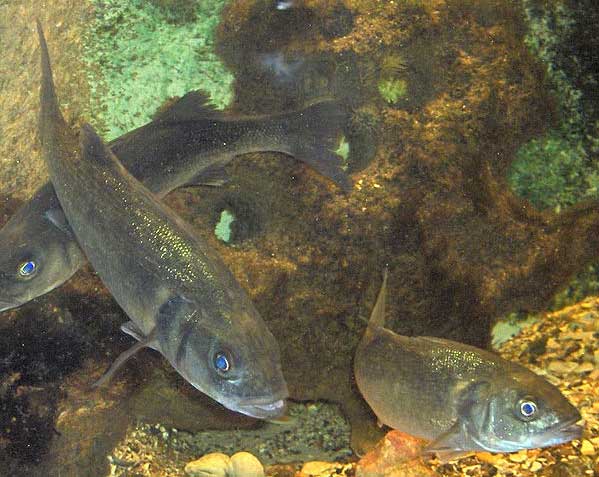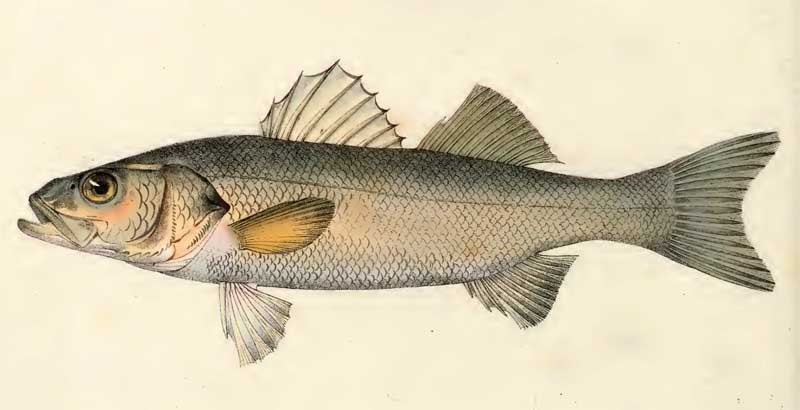
Dicentrarchus labrax (*)
Superregnum: Eukaryota
Cladus: Unikonta
Cladus: Opisthokonta
Cladus: Holozoa
Regnum: Animalia
Subregnum: Eumetazoa
Cladus: Bilateria
Cladus: Nephrozoa
Superphylum: Deuterostomia
Phylum: Chordata
Subphylum: Vertebrata
Infraphylum: Gnathostomata
Megaclassis: Osteichthyes
Superclassis/Classis: Actinopterygii
Classis/Subclassis: Actinopteri
Subclassis/Infraclassis: Neopterygii
Infraclassis: Teleostei
Megacohors: Osteoglossocephalai
Supercohors: Clupeocephala
Cohors: Euteleosteomorpha
Subcohors: Neoteleostei
Infracohors: Eurypterygia
Sectio: Ctenosquamata
Subsectio: Acanthomorphata
Divisio/Superordo: Acanthopterygii
Subdivisio: Percomorphaceae
Series: Eupercaria
Ordo: incertae sedis
Familia: Moronidae
Genus: Dicentrarchus
Species: Dicentrarchus labrax
Name
Dicentrarchus labrax (Linnaeus, 1758)
Original combination: Perca labrax
Synonymy
Centropomus lupus Lacepède, 1802
Centropomus mullus Lacepède, 1802
Dicentrarchus elongatus (Geoffroy St. Hilaire, 1817)
Dicentrarchus lupus (Lacepède, 1802)
Labrax diacanthus (Bloch, 1792)
Labrax elongatus Geoffroy St. Hilaire, 1817
Labrax labrax (Linnaeus, 1758)
Labrax linnei Malm, 1877
Labrax lupus (Lacepède, 1802)
Labrax vulgaris Guérin-Méneville, 1829-38
Morone labrax (Linnaeus, 1758)
Perca diacantha (Bloch, 1792)
Perca elongata Geoffroy St. Hilaire, 1817
Perca punctulata Gmelin, 1789
Perca sinuosa Geoffroy St. Hilaire, 1817
Roccus labrax (Linnaeus, 1758)
Sciaena diacantha Bloch, 1792
Sciaena labrax (Linnaeus, 1758)

References
Linnaeus, C. 1758. Systema Naturae per regna tria naturæ, secundum classes, ordines, genera, species, cum characteribus, differentiis, synonymis, locis, Tomus I. Editio decima, reformata. Holmiæ: impensis direct. Laurentii Salvii. i–ii, 1–824 pp DOI: 10.5962/bhl.title.542: 290. Reference page.
Souche, E.L., Hellemans, B., Babbucci, M., MacAoidh, E., Guinand, B., Bargelloni, L., Chistiakov, D.A., Patarnello, T., Bonhomme, F., Martinsohn, J. T. & Volckaert, F.A.M., 2015: Range-wide population structure of European sea bass Dicentrarchus labrax. Biological Journal of the Linnean Society, 116 (1): 86–105.DOI: 10.1111/bij.12572.
Links
Dicentrarchus labrax in Catalog of Fishes, Eschmeyer, W.N., Fricke, R. & van der Laan, R. (eds.) 2022. Catalog of Fishes electronic version.
Dicentrarchus labrax in FishBase,
Froese, R. & Pauly, D. (eds.) 2022. FishBase. World Wide Web electronic publication, www.fishbase.org, version 08/2021.
Vernacular names
български: Лаврак (lavrak)
català: Llobarro
čeština: Mořčák Evropský, Vlk Mořský, Mořský Vlk, Okoun Mořský
dansk: Bbars, Havbars, Almindelig bars
Deutsch: Europäischer Wolfsbarsch, Seebarsch
Ελληνικά: Λαβράκι (lavráki)
español: Róbalo, Lubina
eesti: Huntahven
suomi: Meribassi
français: Bar, Bar Commun, Bar Européen, Loup, Loup de mer, Loubine, Perche de mer
Gaeilge: Doingean Mara Eorpach
galego: Robalo
עברית: לברק
hrvatski: Lubin
magyar: Farkassügér
italiano: Branzino, Spigola
日本語: ヨーロピアンシーバス
lietuvių: Paprastasis Vilkešeris
latviešu: Labraks, Jūrasasaris
Malti: Spnott
Nederlands: Zeebaars, Europeze Zeebars
polski: Labraks, Moron
português: Robalo
română: Lavrac, Lup de mare, Biban de mare, Biban de mare European
русский: Сибас, Обыкновенный лавра́к (Obyknovennyj lavrák), Лаврак (lavrak)
slovenščina: Brancin
shqip: levrek
svenska: Havsabborre
Türkçe: Levrek, Bayağı Levrek
vèneto: Baìcolo
The European bass (Dicentrarchus labrax) is a primarily ocean-going fish native to the waters off Europe's western and southern and Africa's northern coasts, though it can also be found in shallow coastal waters and river mouths during the summer months. It is one of only six species in its family, Moronidae, collectively called the temperate basses.
It is both fished and raised commercially, and is considered to be the most important fish currently cultured in the Mediterranean. In Ireland and the United Kingdom, the popular restaurant fish sold and consumed as sea bass is exclusively the European bass.[2] In North America it is widely known by one of its Italian names, branzino.[3]
European bass are a slow-growing species that takes several years to reach full adulthood. An adult European seabass usually weighs around 5 kg (11 lb). European bass can reach sizes of up to 1 m (3 ft 3 in) in length and 12 kg (26 lb) in weight, though the most common size is only about half of that at 0.5 m (1 ft 8 in). Individuals are silvery grey in color and sometimes a dark-bluish color on the back.
Juveniles form schools and feed on invertebrates, while adults are less social and prefer to consume other fish. They are generally found in the littoral zone near the banks of rivers, lagoons, and estuaries during the summer, and migrate offshore during the winter. European sea bass feed on prawns, crabs and small fish. Though it is a sought-after gamefish, it is listed as Least Concern by the International Union for Conservation of Nature because it is widespread and there are no known major threats.
Taxonomy and phylogeny
An 1877 illustration of the European bass by British naturalist Jonathan Couch
The European bass was first described in 1758 by Swedish zoologist Carl Linnaeus in his work Systema Naturae. He named it Perca labrax. In the century and a half following, it was classified under a variety of new synonyms, with Dicentrarchus labrax winning out as the accepted name in 1987. Its generic name, Dicentrarchus, derives from Greek, from the presence of two anal spines, "di" meaning two, "kentron" meaning sting, and "archos" meaning anus. The European bass is sold under dozens of common names in various languages. In the British Isles it is known as the "European bass," "European seabass," "common bass," "capemouth," "king of the mullets," "sea bass," "sea dace," "sea perch," "white mullet," "white salmon," or simply "bass".[4]
M. mississippiensis Yellow Bass.gif
M. chrysops Morone chrysops white bass fish (white background).jpg
M. americana Whiteperchnctc (white background).jpg
M. saxatillis Striped bass morone saxatilis fish (white background).jpg
D. punctatus
D. labrax
Phylogenetic tree of Moronidae based on the mt-nd6 protein.[5]
There are two genetically distinct populations of wild European bass. The first is found in the northeast Atlantic Ocean and the second is found in the western Mediterranean Sea. The two populations are separated by a relatively narrow distance in a region known as the Almeria-Oran oceanographic front, located east of the Spanish city of Almería. The exact reason for this separation is unknown, as the geographic divide itself should not account for a lack of gene flow between the two populations. The larval stage of the European bass can last up to 3 months, during which it is unable to swim well, and even a small amount of water flow should transport some individuals between the two regions. In addition, juveniles are able to survive temperature and salinity changes and adults are capable of migrating hundreds of miles.[6]
Distribution and habitat
European bass habitats include estuaries, lagoons, coastal waters, and rivers. It is found in a large part of the eastern Atlantic Ocean, from southern Norway to Senegal. It can also be found in the entire Mediterranean Sea and in the southern Black Sea, but is absent from the Baltic sea.[1] It is a seasonally migratory species, moving further inshore and north in summer.[citation needed]
Diet and behaviour
European bass in their maritime life cycle
The European bass is mostly a night hunter, feeding on small fish, polychaetes, cephalopods, and crustaceans. They spawn from March to June, mostly in inshore waters. As fry they are pelagic, but as they develop they move into estuaries, where they stay for a year or two.[7]
Fisheries and aquaculture
Capture fisheries
Annual catches of wild European bass are relatively modest, having fluctuated between 8,500 and 11,900 tonnes in 2000–2009. Most of the reported catches originate from the Atlantic Ocean, with France typically reporting the highest catches. In the Mediterranean, Italy used to report the largest catches, but has been surpassed by Egypt.[8]
The fish has come under increasing pressure from commercial fishing and became the focus in the United Kingdom of a conservation effort by recreational anglers.[9] The Republic of Ireland has strict laws regarding bass. All commercial fishing for the species is banned and several restrictions are in place for recreational anglers, a closed season May 15 – June 15 inclusive every year, a minimum size of 400 mm, and a bag limit of two fish per day. In a scientific advice (June 2013), it is stressed that fishing mortality is increasing. The total biomass has been declining since 2005. Total biomass, assumed as the best stock size indicator in the last two years (2011–2012), was 32% lower than the total biomass in the three previous years (2008–2010).[10]
Farming
European bass was one of the first types of fish to be farmed commercially in Europe. They were historically cultured in coastal lagoons and tidal reservoirs, before mass-production techniques were developed starting in the late 1960s. It is the most important commercial fish widely cultured in the Mediterranean. The most important farming countries are Greece, Turkey, Italy, Spain, Croatia, and Egypt. Annual production was more than 120,000 tonnes in 2010.[11]
References
Freyhof, J.; Kottelat, M. (2008). "Dicentrarchus labrax". IUCN Red List of Threatened Species. 2008: e.T135606A4159287. doi:10.2305/IUCN.UK.2008.RLTS.T135606A4159287.en. Retrieved 18 November 2021.
"Sea Bass: the Superstar of the Seas". The Independent. 22 October 2011. Retrieved 2017-12-02.
"Definition: Branzino". Popsugr Food. Retrieved 2017-12-02.
Froese, Rainer; Pauly, Daniel (eds.) (2017). "Dicentrarchus labrax" in FishBase. June 2017 version.
Williams, E. P.; A. C. Peer; T. J. Miller; D. H. Secor; A. R. Place (2012). "A phylogeny of the temperate seabasses (Moronidae) characterized by a translocation of the mt-nd6 gene". Journal of Fish Biology. 80 (1): 110–130. doi:10.1111/j.1095-8649.2011.03158.x. PMID 22220893.
Naciri, M.; C. Lemaire; P. Borsa; F. Bonhomme (1999). "Genetic Study of the Atlantic/Mediterranean Transition in Sea Bass (Dicentrarchus labrax)". The Journal of Heredity. 90 (6): 591–596. doi:10.1093/jhered/90.6.591.
The Pocket Guide to Saltwater Fishes of Britain and Europe
FAO Yearbook 2009: Fishery and Aquaculture Statistics: Capture Production (PDF). Rome: Food and Agriculture Organization of the United Nations. 2011. p. 138. Archived from the original (PDF) on 2017-05-19.
Clover, Charles (2004). The End of the Line: How Overfishing Is Changing the World and What We Eat. London: Ebury Press. ISBN 0-09-189780-7.
ICES seabass Advice June 2013
"Dicentrarchus labrax (Linnaeus, 1758 )". Cultured Aquatic Species Information Programme. FAO Fisheries and Aquaculture Department. 2012. Retrieved 12 October 2012.
"Dicentrarchus labrax". Integrated Taxonomic Information System. Retrieved 6 June 2006.
Retrieved from "http://en.wikipedia.org/"
All text is available under the terms of the GNU Free Documentation License

